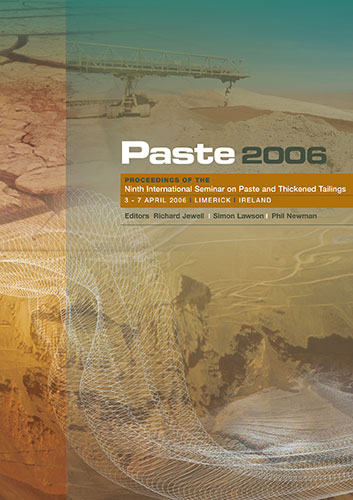Characterisation of Self-Weight Consolidated Paste Backfill

|
Authors: Belem, T; El Aatar, O; Bussiere, B; Benzaazoua, M; Fall, M; Yilmaz, E |
DOI https://doi.org/10.36487/ACG_repo/663_29
Cite As:
Belem, T, El Aatar, O, Bussiere, B, Benzaazoua, M, Fall, M & Yilmaz, E 2006, 'Characterisation of Self-Weight Consolidated Paste Backfill', in R Jewell, S Lawson & P Newman (eds), Paste 2006: Proceedings of the Ninth International Seminar on Paste and Thickened Tailings, Australian Centre for Geomechanics, Perth, pp. 333-345, https://doi.org/10.36487/ACG_repo/663_29
Abstract:
Recent studies showed that for a given mix recipe and curing time the unconfined compressive strength (UCS) of in situ paste backfill (PB) core samples can be 2 to 4 times higher than samples of the same PB mix poured into plastic moulds (Belem et al., 2002; le Roux et al., 2002; Cayouette, 2003; Revell, 2004). Also, the same observations were made for PB samples prepared and cured in laboratory conditions compared to in situ underground PB samples (Belem et al., 2000 and 2001). These differences in compressive strength could be attributed at least in part to the PB hardening (e.g. Benzaazoua et al., 2004) conditions in the stope such as: stope size and geometry, stope walls convergence against the fill mass and its resulting shrinkage (Belem et al., 2004). Other factors of influence are the amount of bleeding water and the gravity-driven consolidation settlement of the PB mass which may depend on its physico-geochemical properties and also on the physical properties of the surrounding rock mass. It was reported that this self-weight consolidation settlement can reach more than 1 m and is usually considered to positively affect the PB strength development (e.g. Belem et al., 2002; le Roux, 2002; Cayouette, 2003). A relatively large number of experimental studies are reported in the literature on the self-weight consolidation of granular slurries, debris, dredge materials or waste rock and mine tailings (e.g. Been and Sills, 1981; Wickland and Wilson, 2005). The originality of the present study, however, is that it considers high density slurry (solids mass concentration ranging from 70% to 85% w/w). To the knowledge of the authors, only very few investigations on the consolidation behaviour of PB have been completed to date (e.g. Belem et al., 2002; le Roux et al., 2002). The purpose of this paper is to characterize the physical and mechanical properties of PB prepared at Louvicourt mine paste backfill plant, poured and cured into 3 m high PVC/Makrolon® polycarbonate sheet settling columns following three scenarios: fully-drained (FD), half-drained (HD) and undrained (UD) conditions. The main objective is to better understand the effect of self-weight consolidation settlement of PB on its physical and mechanical properties.
References:
Been, K. and Sills, G.C. (1981) Self-weight consolidation of soft soils: an experimental and theoretical study, Géotechnique, 31, 4,
pp. 519–535.
Belem, T., Benzaazoua, M., Bussière, B. and Dagenais, A.-M. (2002) Effects of settlement and drainage on strength development
within mine paste backfill, in Proceedings of Tailings and Mine Waste'02, 27-30 January 2002, Fort Collins, Colorado,
Balkema, Rotterdam, pp. 139–48.
Belem, T., Benzaazoua, M. and Bussière, B. (2000) Mechanical behaviour of cemented paste backfill, in Proceedings of 53th
Canadian Geotechnical Conference: "Geotechnical Engineering at the dawn of the third millennium", 15-18 October 2000,
Montréal, Vol. 1, pp. 373-380.
Belem, T., Bussière, B. and Benzaazoua, M. (2001) The effect of microstructural evolution on the physical properties of paste
backfill, in Proceedings of Tailings and Mine Waste'01, January 16-19, Fort Collins, Colorado, A.A. Balkema, Rotterdam, pp.
365–374.
Belem, T., Harvey, A., Simon, R. and Aubertin, M. (2004) Measurement and prediction of internal stresses in an underground
opening during its filling with cemented fill, in Proceedings of the 5th Int. Symp. on Ground Support in Mining and
Underground Construction. Villaescusa & Potvin (eds.), 28-30 September 2004, Perth, Western Australia, Australia, Tayler &
Francis Group, London, pp. 619 – 630.
Benzaazoua, M., Belem, T. and Jolette, D. (2000) Chemical stability investigation and its impact on the quality of cemented backfill
(in French), IRSST Report No. R-260, 172p.
Benzaazoua, M., Fall, M. and Belem, T. (2004) A contribution to understanding the hardening process of cemented pastefill,
Minerals Engineering. 17, 2, pp. 141–152.
Cayouette, J. (2003) Optimization of the paste backfill plant at Louvicourt mine, CIM Bulletin, 96, 1075, pp. 51-57.
le Roux, K.A., Bawden, W.F. and Grabinsky, M.W.F. (2002) Assessing the interaction between hydration rate and fill rate for a
cemented paste backfill, In Proceedings on the 55th Canadian Geotechnical and 3rd joint IAH-CNC Groundwater specialty
Conferences, Niagara Falls, Ontario, October, 20-23, 2002, pp. 427-432.
Revell M.B. (2004) Paste – How strong is it? In Proceedings of the 8th International Symposium on Mining with Backfill, Septembre
2004, Beijing, The Nonferrous Metals Society of China, pp. 286-294.
Wickland, B.E. and Wilson, G.W. (2005) Self-weight consolidation of mixtures of mine waste rock and tailings, Can. Geotech. J. 42,
pp. 327–339.
Paste2006,Limerick,Ireland 345
Mine BAcKfill
© Copyright 2025, Australian Centre for Geomechanics (ACG), The University of Western Australia. All rights reserved.
View copyright/legal information
Please direct any queries or error reports to repository-acg@uwa.edu.au
View copyright/legal information
Please direct any queries or error reports to repository-acg@uwa.edu.au